Table of Contents
Email is the lifeline for the modern organization. It’s used to communicate, set meetings, share documents, discuss privileged information, shield corporate secrets, and more (both internally and externally, might I add). Despite all the positive strides we’ve made in cybersecurity, attackers are evolving just as fast—if not faster. New tactics like AI-generated phishing and sophisticated social engineering continue to change the playing field. So, how can you keep up?
GenAI phishing schemes, credential theft, outbound data leaks, and human error are just a handful of tactics on the rise. The following four pillars stressed by Gartner form a comprehensive strategy to safeguard your organization against the prominent email threats your business faces today.

The purpose of this blog is to educate and inform. I'm going to unpack the importance of each pillar, what they can do to improve your overall security posture, and how they affect different organizations. Let's get into it.
1. AI-Powered Phishing and Quishing Detection: Combating Evolving Tactics
First and foremost, among Gartner’s tenets is Generative AI phishing detection. GenAI is reshaping phishing, enabling attackers to craft emails that mimic human-like writing with eerie precision. These AI phishing and quishing emails evade traditional filters, effectively exploiting user trust. In July, Security Magazine highlighted a new wave of malicious phishing kits available for purchase on the dark web. The problem is only growing.
To counteract these risks, AI/ML-based solutions play a pivotal role. Technologies like Natural Language Processing (NLP), computer vision, and social graph analysis identify subtle inconsistencies in language, logos, and sender history. Businesses must adopt AI-driven detection tools to block malicious content proactively. By deploying AI solutions to detect these types of phishing attempts, organizations can drastically reduce exposure while simultaneously easing manual workloads.
2. Identity Theft Protection: The Shield Against Account Takeovers (ATOs)
Credential theft remains a lucrative avenue for attackers and earns its place as pillar number two in Gartner’s tenets. Email accounts are often gateways to SaaS platforms like Microsoft 365, enabling attackers to steal sensitive data and launch subsequent attacks. To defend against identity-based threats, organizations must enforce phishing-resistant multifactor authentication (MFA) and adopt solutions with identity threat detection and response (ITDR) capabilities.
Advanced techniques, such as analyzing impossible travel events or geolocation mismatches, can identify anomalies before they escalate into breaches. Strengthening sender verification protocols like DMARC, SPF, and DKIM further deters spoofing, ensuring only authenticated messages reach users. The days of simple identity theft protection are behind us—complex, proactive measures are now a necessity.
3. Outbound Email Security: Securing Data Leaving the Organization
While inbound threats often dominate the narrative, outbound security is just as critical in the email security symphony. Misdirected emails or compromised accounts can leak sensitive information, damaging reputations, straining partner relationships, and potentially violate compliance mandates.
Accidental Data Exposure (ADE) and Data Loss Prevention (DLP) solutions are indispensable for monitoring and controlling outbound email content. These systems alert users of potential mistakes—like misaddressed emails or unauthorized sharing of sensitive files. Real-time nudges, such as context-aware banners, educate users as they compose messages, reducing human error. AI-driven tools for outbound protection allow organizations to safeguard data and mitigate insider risks.
4. Continuous User Education: Building the Frontline of Defense
Despite technological advancements, human error remains a significant vulnerability (as the Verizon DBIR statistics remind us). While regular, role-specific training empowers employees to recognize and report phishing attempts, that alone is no longer enough. To maximize impact, training should incorporate real-world examples and interactive elements like phishing simulations and security quizzes.
Gartner's Secure Behavior and Culture Program (PIPE framework) emphasizes fostering secure habits—not just awareness. Embedding security cues into workflows, such as warning banners or real-time feedback, keeps email security top of mind and ensures users remain vigilant as a crucial frontline of defense. Cultivating a culture of security awareness must remain a top priority for your business.
Where do I go from here?
The insights discussed in this article go beyond quick, short-term fixes. Acting on known information is just as critical as acquiring it. Let’s take a moment to break this down specifically for small and medium-sized businesses (SMBs), as well as enterprise organizations.
What This Means for SMBs
For small and medium-sized businesses (SMBs) with less mature cybersecurity frameworks, the four tenets represent a crucial blueprint for leveling the playing field against today’s threat actors. Many SMBs rely heavily on native email security features or have even invested in a SEG. Unfortunately, these tools often fail to detect advanced attacks like GenAI phishing or credential theft attempts.
Implementing AI-powered solutions might seem daunting, but these tools can be game-changers for SMBs by weaving automation into processes, thereby reducing dependency on limited IT resources. In addition to AI-powered email security solutions, investing in outbound email security and dynamic Security Awareness Training (SAT) can mitigate risks stemming from human error—a common vulnerability for smaller teams. SMBs must prioritize scalable, cost-effective solutions that align with their growth without sacrificing protection.
What This Means for Enterprises
For larger organizations (I’ll refer to them as enterprises), the four tenets emphasize the need to stay ahead of today’s developing threats. While many enterprises already use advanced tools, the rapidly evolving tactics of cybercriminals demand continual adaptation and investment. AI-backed email security is only a starting point; business leaders must assess which additional capabilities and features are necessary to meet their unique risk management needs.
Mature enterprises must also integrate these capabilities across diverse communication platforms like Teams and Slack, ensuring seamless protection in hybrid or remote work environments. With higher stakes involving compliance, brand reputation, and sensitive data distribution, enterprises must extend their focus to proactive user education and outbound ADE or DLP. Even the best technology in the market is only as strong as the user operating said technology. Strong technology must be augmented by an educated workforce to assure the highest level of resilience for the larger enterprises.
The IRONSCALES Perspective
Here at IRONSCALES, we’ve integrated many of these strategies into our clients’ security programs for years. Our AI-powered email security solution stops even the most advanced phishing attacks. Features like continuous behavioral analysis of inboxes help protect MFA from phishing, while our integrated SAT and personalized spear phishing testing prepare employees with realistic simulations. Together, these tools create a stronger, smarter approach to email security.
Other aspects of Gartner’s recommendations are recent points of focus for us (stay tuned for some exciting announcements in a couple of weeks). Phishing isn’t just about the financial losses, it’s also an endless drain on security teams, pulling them into constant incident management and away from the strategic priorities that drive innovation. That’s why we’ve designed our platform to lighten the load, using AI to automate threat detection and remediation.
It's clear traditional email security simply isn’t enough. Organizations need to adopt these four tenets to stay ahead of the tools threat actors can simply purchase off the dark web today.
Your business needs a partner that goes beyond the basics, combining AI-driven technology with practical tools to protect your people, data, and trust. It’s time to take email security off your team’s worry list. Let’s build a safer, smarter future together.
Explore More Articles
Say goodbye to Phishing, BEC, and QR code attacks. Our Adaptive AI automatically learns and evolves to keep your employees safe from email attacks.

/Concentrix%20Case%20Study.webp?width=568&height=326&name=Concentrix%20Case%20Study.webp)












.webp?width=100&height=100&name=PXL_20220517_081122781%20(1).webp)

